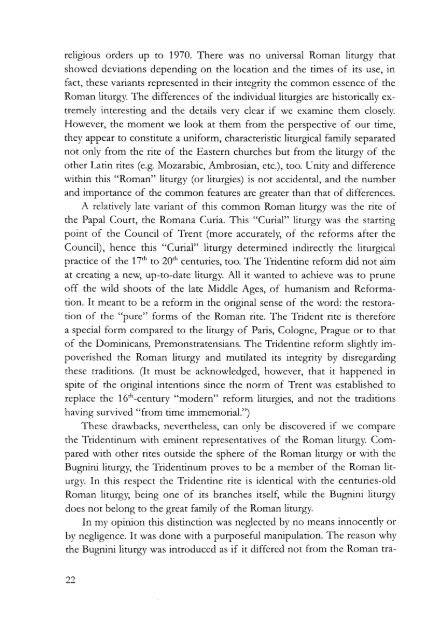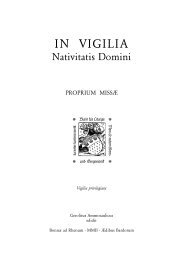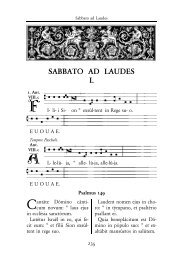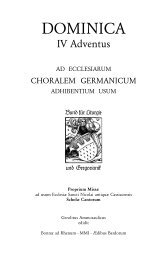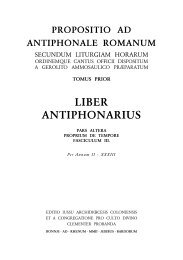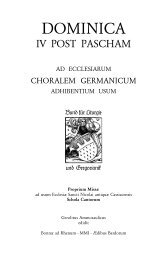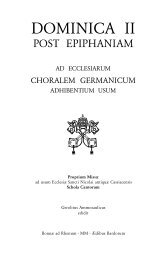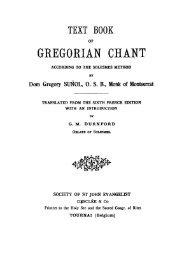The Bugnini-Liturgy and the Reform of the Reform - MusicaSacra
The Bugnini-Liturgy and the Reform of the Reform - MusicaSacra
The Bugnini-Liturgy and the Reform of the Reform - MusicaSacra
You also want an ePaper? Increase the reach of your titles
YUMPU automatically turns print PDFs into web optimized ePapers that Google loves.
eligious orders up to 1970. <strong>The</strong>re was no universal Roman liturgy that<br />
showed deviations depending on <strong>the</strong> location <strong>and</strong> <strong>the</strong> times <strong>of</strong> its use, in<br />
fact, <strong>the</strong>se variants represented in <strong>the</strong>ir integrity <strong>the</strong> common essence <strong>of</strong> <strong>the</strong><br />
Roman liturgy. <strong>The</strong> differences <strong>of</strong> <strong>the</strong> individual liturgies are historically extremely<br />
interesting <strong>and</strong> <strong>the</strong> details very clear if we examine <strong>the</strong>m closely.<br />
However, <strong>the</strong> moment we look at <strong>the</strong>m from <strong>the</strong> perspective <strong>of</strong> our time,<br />
<strong>the</strong>y appear to constitute a uniform, characteristic liturgical family separated<br />
not only from <strong>the</strong> rite <strong>of</strong> <strong>the</strong> Eastern churches but from <strong>the</strong> liturgy <strong>of</strong> <strong>the</strong><br />
o<strong>the</strong>r Latin rites (e.g. Mozarabic, Ambrosian, etc.), too. Unity <strong>and</strong> difference<br />
within this "Roman" liturgy (or liturgies) is not accidental, <strong>and</strong> <strong>the</strong> number<br />
<strong>and</strong> importance <strong>of</strong> <strong>the</strong> common features are greater than that <strong>of</strong> differences.<br />
A relatively late variant <strong>of</strong> this common Roman liturgy was <strong>the</strong> rite <strong>of</strong><br />
<strong>the</strong> Papal Court, <strong>the</strong> Romana Curia. This "Curial" liturgy was <strong>the</strong> starting<br />
point <strong>of</strong> <strong>the</strong> Council <strong>of</strong> Trent (more accurately, <strong>of</strong> <strong>the</strong> reforms after <strong>the</strong><br />
Council), hence this "Curial" liturgy determined indirectly <strong>the</strong> liturgical<br />
practice <strong>of</strong> <strong>the</strong> 17 th to 20 th centuries, too. <strong>The</strong> Tridentine reform did not aim<br />
at creating a new, up-to-date liturgy. All it wanted to achieve was to prune<br />
<strong>of</strong>f <strong>the</strong> wild shoots <strong>of</strong> <strong>the</strong> late Middle Ages, <strong>of</strong> humanism <strong>and</strong> <strong>Reform</strong>ation.<br />
It meant to be a reform in <strong>the</strong> original sense <strong>of</strong> <strong>the</strong> word: <strong>the</strong> restoration<br />
<strong>of</strong> <strong>the</strong> "pure" forms <strong>of</strong> <strong>the</strong> Roman rite. <strong>The</strong> Trident rite is <strong>the</strong>refore<br />
a special form compared to <strong>the</strong> liturgy <strong>of</strong> Paris, Cologne, Prague or to that<br />
<strong>of</strong> <strong>the</strong> Dominicans, Premonstratensians. <strong>The</strong> Tridentine reform slightly impoverished<br />
<strong>the</strong> Roman liturgy <strong>and</strong> mutilated its integrity by disregarding<br />
<strong>the</strong>se traditions. (It must be acknowledged, however, that it happened in<br />
spite <strong>of</strong> <strong>the</strong> original intentions since <strong>the</strong> norm <strong>of</strong> Trent was established to<br />
replace <strong>the</strong> 16 th -century "modern" reform liturgies, <strong>and</strong> not <strong>the</strong> traditions<br />
having survived "from time immemorial.")<br />
<strong>The</strong>se drawbacks, never<strong>the</strong>less, can only be discovered if we compare<br />
<strong>the</strong> Tridentinum with eminent representatives <strong>of</strong> <strong>the</strong> Roman liturgy. Compared<br />
with o<strong>the</strong>r rites outside <strong>the</strong> sphere <strong>of</strong> <strong>the</strong> Roman liturgy or with <strong>the</strong><br />
<strong>Bugnini</strong> liturgy, <strong>the</strong> Tridentinum proves to be a member <strong>of</strong> <strong>the</strong> Roman liturgy.<br />
In this respect <strong>the</strong> Tridentine rite is identical with <strong>the</strong> centuries-old<br />
Roman liturgy, being one <strong>of</strong> its branches itself, while <strong>the</strong> <strong>Bugnini</strong> liturgy<br />
does not belong to <strong>the</strong> great family <strong>of</strong> <strong>the</strong> Roman liturgy.<br />
In my opinion this distinction was neglected by no means innocently or<br />
by negligence. It was done with a purposeful manipulation. <strong>The</strong> reason why<br />
<strong>the</strong> <strong>Bugnini</strong> liturgy was introduced as if it differed not from <strong>the</strong> Roman tra-


